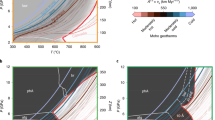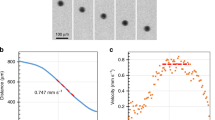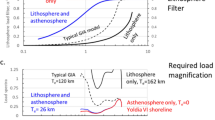Abstract
The Earth has distinctive convective behaviour, described by the plate tectonics model, in which lateral motion of the oceanic lithosphere of basaltic crust and peridotitic uppermost mantle is decoupled from the underlying mechanically weaker upper mantle (asthenosphere). The reason for differentiation at the lithosphere–asthenosphere boundary is currently being debated with relevant observations from geophysics (including seismology) and geochemistry (including experimental petrology). Water is thought to have an important effect on mantle rheology, either by weakening the crystal structure of olivine and pyroxenes by dilute solid solution1, or by causing low-temperature partial melting2. Here we present a novel experimental approach to clarify the role of water in the uppermost mantle at pressures up to 6 GPa, equivalent to a depth of 190 km. We found that for lherzolite in which a water-rich vapour is present, the temperature at which a silicate melt first appears (the vapour-saturated solidus) increases from a minimum of 970 °C at 1.5 GPa to 1,350 °C at 6 GPa. We have measured the water content in lherzolite to be approximately 180 parts per million, retained in nominally anhydrous minerals at 2.5 and 4 GPa at temperatures above and below the vapour-saturated solidus. The hydrous mineral pargasite is the main water-storage site in the uppermost mantle, and the instability of pargasite at pressures greater than 3 GPa (equivalent to more than about 90 km depth) causes a sharp drop in both the water-storage capacity and the solidus temperature of fertile upper-mantle lherzolite. The presence of interstitial melt in mantle with more than 180 parts per million of water at pressures greater than 3 GPa alters mantle rheology and defines the lithosphere–asthenosphere boundary. Modern asthenospheric mantle acting as the source for mid-oceanic ridge basalts has a water content of 50–200 parts per million (refs 3–5). We show that this matches the water content of residual nominally anhydrous minerals after incipient melting of lherzolite at the vapour-saturated solidus at high pressure.
This is a preview of subscription content, access via your institution
Access options
Subscribe to this journal
Receive 51 print issues and online access
$199.00 per year
only $3.90 per issue
Buy this article
- Purchase on Springer Link
- Instant access to full article PDF
Prices may be subject to local taxes which are calculated during checkout



Similar content being viewed by others
References
Hirth, G. & Kohlstedt, D. L. Water in the oceanic upper mantle: implications for rheology, melt extraction and the evolution of the lithosphere. Earth Planet. Sci. Lett. 144, 93–108 (1996)
Green, D. H. & Falloon, T. J. in The Earth's Mantle (ed. Jackson, I.) 311–378 (Cambridge Univ. Press, 1998)
Michael, P. J. Regionally distinctive sources of depleted MORB: evidence from trace elements and H2O. Earth Planet. Sci. Lett. 170, 215–239 (1995)
Danyushevsky, L. V., Eggins, S. M., Falloon, T. J. & Christie, D. M. H2O abundance in depleted to moderately enriched mid-ocean ridge magmas; Part I: incompatible behaviour, implications for mantle storage, and origin of regional variations. J. Petrol. 41, 1329–1364 (2000)
Sobolev, A. V. & Chaussidon, M. H2O concentrations in primary melts from supra-subduction zones and mid-ocean ridges: implications for water storage and recycling in the mantle. Earth Planet. Sci. Lett. 137, 45–55 (1996)
Wyllie, P. J. Mantle fluid compositions buffered in peridotite–CO2–H2O by carbonates, amphibole, and phlogopite. J. Geol. 86, 687–713 (1978)
Green, D. H. Compositions of basaltic magmas as indicators of conditions of origin: application to oceanic volcanism. Phil. Trans. R. Soc. Lond. A 268, 707–725 (1971)
Green, D. H. Experimental melting studies on a model upper mantle composition at high pressures under water-saturated and water-undersaturated conditions. Earth Planet. Sci. Lett. 19, 37–53 (1973)
Hirschmann, M. M. Water, melting, and the deep Earth H2O cycle. Annu. Rev. Earth Planet. Sci. 34, 629–653 (2006)
Asimow, P. D., Dixon, J. E. & Langmuir, C. H. A hydrous melting and fractionation model for mid-ocean ridge basalts: application to the Mid-Atlantic Ridge near the Azores. Geochem. Geophys. Geosyst. 5, 1–24 (2004)
Tenner, T. J., Hirschmann, M. M., Withers, A. C. & Hervig, R. L. Hydrogen partitioning between nominally anhydrous upper mantle minerals and melt between 3 and 5 GPa and applications to hydrous peridotite partial melting. Chem. Geol. 262, 42–56 (2009)
McKenzie, D. & Bickle, M. J. The volume and composition of melt generated by extension of the lithosphere. J. Petrol. 29, 625–679 (1988)
Artemieva, I. M. The continental lithosphere: reconciling thermal, seismic and petrologic data. Lithos 109, 23–44 (2009)
Thybo, H. The heterogeneous upper mantle low velocity zone. Tectonophysics 416, 53–79 (2006)
Grove, T. L., Chatterjee, N., Parman, S. W. & Medard, E. The influence of H2O on mantle wedge melting. Earth Planet. Sci. Lett. 249, 74–89 (2006)
Milhollen, G., Irving, A. J. & Wyllie, P. J. Melting interval of peridotite with 5.7 per cent water to 30 kilobars. J. Geol. 82, 575–587 (1974)
Niida, K. & Green, D. H. Stability and chemical composition of pargasitic amphibole in MORB pyrolite under upper mantle conditions. Contrib. Mineral. Petrol. 135, 18–40 (1999)
Bowen, N. L. & Tuttle, O. F. The system MgO–SiO2–H2O. Bull. Geol. Soc. Am. 60, 439–460 (1949)
Asahara, Y. & Ohtani, E. Melting relations of the hydrous primitive mantle in the CMAS–H2O system at high pressures and temperatures, and implications for the generation of komatiites. Phys. Earth Planet. Inter. 125, 31–44 (2001)
Green, D. H. Conditions of melting of basanite magma from garnet peridotite. Earth Planet. Sci. Lett. 17, 456–465 (1973)
Brey, G. & Green, D. H. Systematic study of liquidus phase relations in olivine melilitite + H2O + CO2 at high pressures and petrogenesis of an olivine melilitite magma. Contrib. Mineral. Petrol. 61, 141–162 (1977)
Green, D., Nicholls, I., Viljoen, M. & Viljoen, R. Experimental demonstration of the existence of periditic liquids in earliest Archean magmatism. Geology 3, 11–14 (1975)
Mibe, K. et al. Second critical endpoint in the peridotite–H2O system. J. Geophys. Res. 112 B03201 10.1029/2005JB004125 (2007)
Kessel, R., Ulmer, P., Pettke, T., Schmidt, M. W. & Thompson, A. B. The water–basalt system at 4 to 6 GPa: phase relations and second critical endpoint in a K-free eclogite at 700 to 1400 °C. Earth Planet. Sci. Lett. 237, 873–892 (2005)
Kovács, I. et al. Quantitative absorbance spectroscopy with unpolarized light, part II: experimental evaluation and development of a protocol for quantitative analysis of mineral IR spectra. Am. Mineral. 93, 765–778 (2008)
Bell, D. R., Ihinger, P. D. & Rossman, G. R. Quantitative analysis of trace OH in garnet and pyroxenes. Am. Mineral. 80, 465–474 (1995)
Bell, D. R., Rossman, G. R., Maldener, J., Endisch, D. & Rauch, F. Hydroxide in olivine: a quantitative determination of the absolute amount and calibration of the IR spectrum. J. Geophys. Res. B 108 2105 10.1029/2001JB000679 (2003)
Niida, K., Green, D. H., Yoshikawa, M. & Eggins, S. M. Dunite channels in the Horoman peridotites, Japan: textural and geochemical constraints on melt/fluid transport through the lithosphere. Geochim. Cosmochim. Acta 70, A445 (2006)
Faul, U. H. & Jackson, I. N. S. Diffusion creep of dry, melt-free olivine. J. Geophys. Res. 112 B04204 10.1029/2006JB004586 (2007)
Faul, U. H. Melt retention and segregation beneath mid-ocean ridges. Nature 410, 920–923 (2001)
Acknowledgements
We thank H. St C. O’Neill, J. Hermann and G. M. Yaxley for discussions, and F. Brink for comprehensive support at scanning electron microscopy (SEM) facilities. We appreciate the help of J. Blundy in the revision of the original manuscript. This research was supported by Australian Research Council grants to D.H.G., and to G. M. Yaxley and D.H.G. I.K. was supported by an A. E. Ringwood Memorial Scholarship, an Australian International Postgraduate Research Scholarship and a Marie Curie International Reintegration Grant (NAMS-230937). A.R. was supported by an Australian National University PhD Scholarship.
Author information
Authors and Affiliations
Contributions
D.H.G. initiated and planned the project, and made most of the SEM micro-analyses. W.O.H. carried out the high-pressure experimental work and prepared the experimental charges for SEM analysis. A.R. did some 6 GPa experiments, assisted in SEM analyses and compiled all the analyses. I.K. prepared the thin sections for FTIR analyses, performed the FTIR spectroscopy and processed the data. All authors contributed to the writing of the manuscript.
Corresponding author
Ethics declarations
Competing interests
The authors declare no competing financial interests.
Supplementary information
Supplementary Information
This file contains Supplementary Figures 1-2 with legends and Supplementary Tables 3-4. (PDF 1023 kb)
Rights and permissions
About this article
Cite this article
Green, D., Hibberson, W., Kovács, I. et al. Water and its influence on the lithosphere–asthenosphere boundary. Nature 467, 448–451 (2010). https://doi.org/10.1038/nature09369
Received:
Accepted:
Issue Date:
DOI: https://doi.org/10.1038/nature09369
This article is cited by
-
The Pannon LitH2Oscope magnetotelluric array in the Pannonian Basin
Acta Geodaetica et Geophysica (2024)
-
Mantle wedge oxidation from deserpentinization modulated by sediment-derived fluids
Nature Geoscience (2023)
-
Plate tectonics in the twenty-first century
Science China Earth Sciences (2023)
-
Fractional crystallisation of eclogite during the birth of a Hawaiian Volcano
Nature Communications (2022)
-
Geochemical insights into mantle metasomatism from cogenetic plutonic xenoliths in pyroclastic deposits of Gölcük volcano and their alkaline host rocks (Isparta, SW Turkey)
Mediterranean Geoscience Reviews (2022)
Comments
By submitting a comment you agree to abide by our Terms and Community Guidelines. If you find something abusive or that does not comply with our terms or guidelines please flag it as inappropriate.



